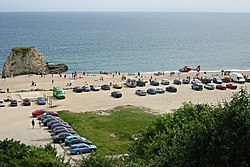Carlyon Bay
| Carlyon Bay | |
| Cornwall | |
|---|---|
 Carlyon Bay Beach | |
| Location | |
| Grid reference: | SX046521 |
| Location: | 50°20’10"N, 4°43’55"W |
| Data | |
| Post town: | St Austell |
| Postcode: | PL25 |
| Local Government | |
| Council: | Cornwall |
Carlyon Bay is village built around a bay with three beaches near St Austell on the south coast of Cornwall. It is about two miles south of St Austell town centre and its fortune comes from the beaches, known as Crinnis, Shorthorn and Polgaver.
The name of the bay is from the Cornish Caryones, meaning 'forts'.
Between 1920 and the Second World War, Carlyon Bay was the site of the New Cornish Riviera Lido and large sports facilities. After the war it became known as the Cornish Leisure World. A large venue, the Cornwall Coliseum, opened in the 1950s. The Coliseum hosted exhibitions, tennis tournaments and many concerts by leading musicians, but lost its importance with the opening of the Plymouth Pavilions in 1991.[1][2][3] The venue continued until early 2003 when only the Gossips nightclub remained open, until its closure too shortly after. The building still stands but has fallen into disrepair.[1]

Since the 1990s there have been plans for development of homes and a resort complex.
The area surrounding the bay was a centre of the mining industry and is now a golf course. The South West Coast Path runs along the cliff top and across the golf course. The Cliff Head Hotel was established in 1934.
On film
In 1979 a scene for the film Dracula was filmed at Carlyon Bay[4]
In 1986, the music video for Is This Love? by Alison Moyet was filmed on the beach.
Redevelopment plans


The original 1990 planning permission for redevelopment into 500 homes was at first not realised, the main obstacle being the need for better sea defences.[5]
In July 2011, the Council approved a new planning application for 500 luxury apartments and associated facilities.[6] The private developers (originally Ampersand now called Commercial Estates Group) were planning to begin work on the new sea defences in late 2011 and on the apartments in spring 2012.[7] However, plans were put on hold in December 2012 and construction had not started by August 2014.[8] There has been a lot of local opposition to the developers. One point of contention is two public right of way through the site. At public enquiry in June 2014 Cornwall Council recognised the existence of the rights of way, CEG has exercised its right to appeal and decision now rests with the Secretary of State.[9][10]
Another point of contention has been the sea defences. The original 1990 plans propose a large sea wall. Following local protests a public inquiry was held in 2006 which rejected the plans. A revised scheme was accepted in 2011 but construction has not yet started. Temporary sheet piling defences were installed in early 2000s without planning permission, the developers were asked to remove it in 2008 but they have remained until 2014. A planning application for temporary defences was rejected in November 2013 and in May 2014 Cornwall Council resolved to take enforcement action for the removal of the temporary wall.[11]
Geography and geology
Carlyon Bay is surrounded by low cliffs and is divided into three areas: Crinnis, Shorthorn and Polgaver. Much of the sand on the beach is actually waste material from the china clay industry known as "stent". Cornwall Wildlife Trust has identified Shorthorn Beach (the middle beach of the three) as a site of national importance.
Outside links
| ("Wikimedia Commons" has material about Carlyon Bay) |
References
- ↑ 1.0 1.1 Carlyon Bay – History (Commercial Estates Group)
- ↑ History of Carlyon Bay's beaches - Carlyon Bay Watch
- ↑ Praising 20 years of the Pavilions, Plymouth Herald, 16 September 2011.
- ↑ Dracula - locations on the Internet Movie Database
- ↑ New Carlyon Bay plans submitted, Business Cornwall, 3 March 2011.
- ↑ 'World-class' development approved for Carlyon Bay, This is Cornwall, 6 July 2011.
- ↑ Who are we?, The Carlyon Bay Development.
The Carlyon Next steps, Bay Development. - ↑ "Latest News - Section December 6th 2012". 6 December 2012. http://www.carlyonbaywatch.com/page_22.html. Retrieved 20 August 2014.
- ↑ "Public Access". Carlyon Bay Watch. http://www.carlyonbaywatch.com/public_access_39.html. Retrieved 20 August 2014.
- ↑ "Date set for Carlyon Bay beach front footpath public inquiry". Cornish Guardian. 6 May 2014. http://www.cornishguardian.co.uk/Date-set-Carlyon-Bay-beach-footpath-public/story-21029085-detail/story.html. Retrieved 20 August 2014.
- ↑ "Carlyon Bay developers ordered to remove sea wall from Cornwall beach". Western Daily Press. 21 April 2014. http://www.westerndailypress.co.uk/Carlyon-Bay-developers-ordered-remove-sea-wall/story-20988544-detail/story.html. Retrieved 20 August 2014.
